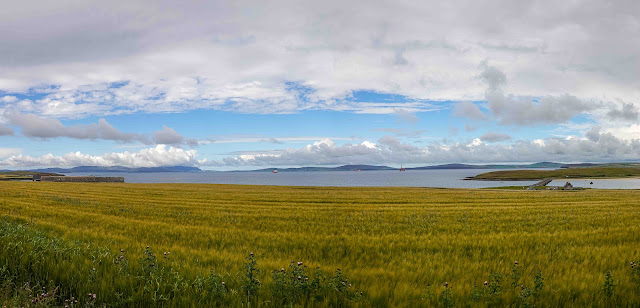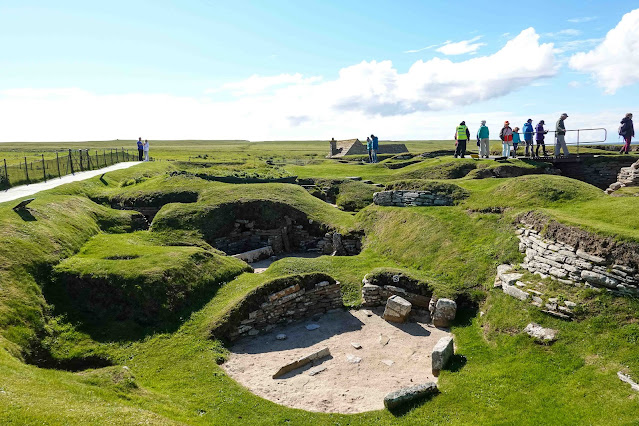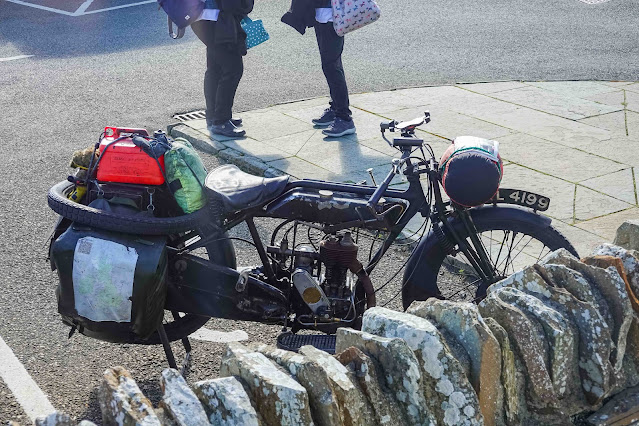Day 24 - August 4, 2022 - Orkney Isles - Sheep Farm
Today was a long and tiring day. We had an early breakfast and left on a walking tour of Kirkwell at 8:30 AM. Some of the sights we saw were ones we saw yesterday on our own, but today with a local guide we learned a great deal more about the history of Orkney.
Early morning from our pier.
I know several photos of the Cathedral were included in yesterdays post, but I couldn't resist just a few more. This building fascinates me. If you start counting from the date it was completed, it is almost 900 years old, and still a functioning church.
Just look at this entrance!
After our town tour, we boarded our bus and made a 40 minute ride to the Churchill barriers and the Italian Chapel located on Lambholm Island.
The Italian Chapel is a highly ornate Catholic chapel on Lamb Holm in the Orkney Islands. It was built during World War II by Italian prisoners of war, who were housed on the previously uninhabited island while they constructed the Churchill Barriers to the east of Scapa Flow.
We had a very interesting guide for the Chapel. She was 80 years old and was 8 when the Italians prisoners were here constructing the Church barrier and the Chapel. More will be said about the barrier, but the locals got along very well with the prisoners. When the poisoners were transferred from Orkney, her grandfather promised them that he would make sure the Chapel was taken care of.
On 14 October 1939, the Royal Navy battleship HMS Royal Oak was sunk at her moorings within the natural harbor of Scapa Flow (where much of the Royal Navy was located) by the German submarine U-47 under the command of Günther Prien. U-47 had entered Scapa Flow through Holm Sound, one of several eastern entrances to Scapa Flow.
The eastern passages were protected by measures including sunken block ships, booms and anti-submarine nets, but U-47 entered at night at high tide by navigating between the block ships.
To prevent further attacks, the First Lord of The Admiralty Winston Churchill ordered the construction of permanent barriers. Work began in May 1940 and the barriers were completed in September 1944 but were not officially opened until 12 May 1945, four days after Victory in Europe Day.
Work on the barriers were initially by Englishmen and Irish, but since almost all able bodied men were away at war, the work progressed slowly. 600 Italian POW's were brought in to do the work and were allowed to construct the Chapel as a means of improving moral.
The highlighted areas show where the barriers were built. It was quite an undertaking using 5 and 10 ton concrete cubes.
A closer look at one of the barriers.
Leaving the southern part of the Orkneys we traveled back to the ship for lunch and a brief break. We then departed at 2:30 for the western part of the island to view some of the oldest Neolithic sites in the world.
As shown below, there is still a lot of active archeological activity taking place.
The Ring of Brodgar is a Neolithic henge and stone circle about 6 miles north-east of Stromness on Mainland, the largest island in Orkney. It is part of the UNESCO World Heritage Site known as the Heart of Neolithic Orkney.
Janet, Carl and Kay. The temperature was about 58 degrees and the wind a steady 20 mph, with higher gusts.
The stone circle is 341 feet in diameter, and the third largest in the British Isles. The ring originally comprised up to 60 stones, of which only 27 remained standing at the end of the 20th century. It is generally thought to have been erected between 2500 BC and 2000 BC, and was, therefore, the last of the great Neolithic monuments built on the Ness.
Kay and Janet enjoying the wind.
We next visited Skara Brae. Skara Brae is a stone-built Neolithic settlement, located on the Bay of Skaill on the west coast of Mainland of Orkney.
The site was occupied from roughly 3180 BC to about 2500 BC and is Europe's most complete Neolithic village. Older than Stonehenge and the Great Pyramids of Giza, it has been called the "Scottish Pompeii" because of its excellent preservation.
In the parking lot of Skara Brae, I spotted this beauty. I was already on the bus, but I talked with a fellow traveler who was knowledgeable about cycles and he said the only marking he could find was on the engine block which was "Sunbeam". Of course that probably isn't the original engine. Any idea Major what this is? It has certainly been around.
Finally we come to the Stenness Standing Stones.
The Stones of Stenness may be the earliest henge monument in the British Isles, built about 5,400 years ago. Their function is unclear, but our best guess is that they were involved in activities and ceremonies celebrating the relationship between living and past communities.
Well, it's almost 11:00 PM and the ship is in pretty rough water, the captain said he was expecting 6 foot swells or more and I feel it. Time to go to bed... Tomorrow we will be in the Eastern Hebrides.







































Comments
Post a Comment